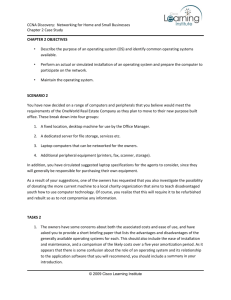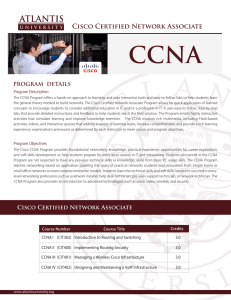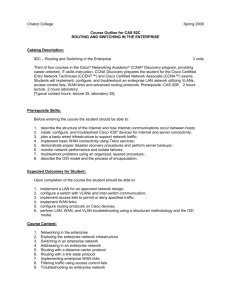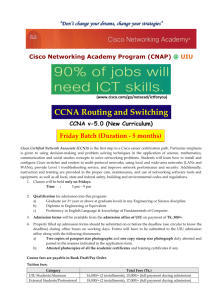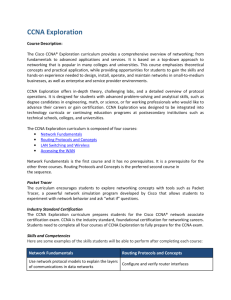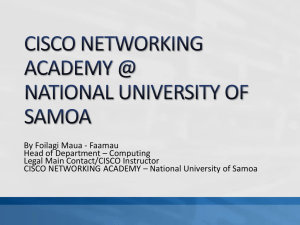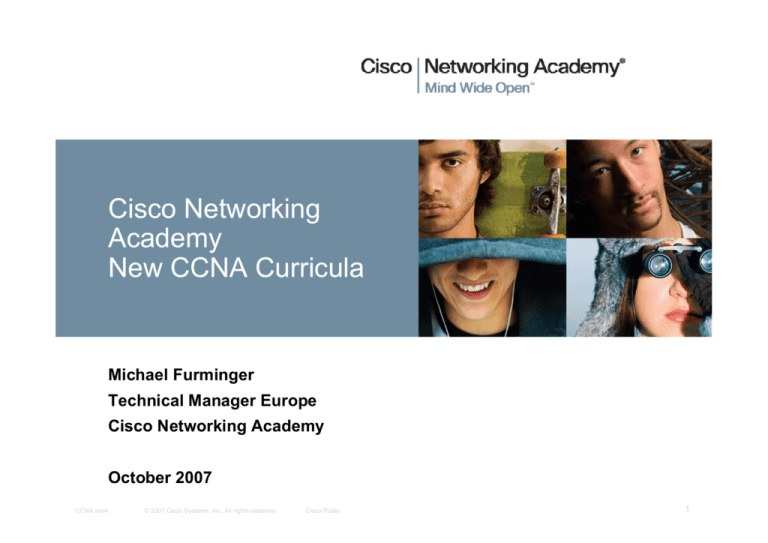
Cisco Networking
Academy
New CCNA Curricula
Michael Furminger
Technical Manager Europe
Cisco Networking Academy
October 2007
CCNA rev4
© 2007 Cisco Systems, Inc. All rights reserved.
Cisco Public
1
Contents
New CCNA Overview
Adoption and Migration
CCNA Discovery Detail
CCNA Exploration Detail
Instructor Training
Cisco Certifications
CCNA rev5
© 2007 Cisco Systems, Inc. All rights reserved.
Cisco Public
2
New Courses
CCNA rev5
© 2007 Cisco Systems, Inc. All rights reserved.
Cisco Public
3
How Are We Evolving the Program?
Shift focus from program growth to student
outcomes
Develop courseware tailored to student goals
Align skills with specific jobs in networking
CCNA rev5
© 2007 Cisco Systems, Inc. All rights reserved.
Cisco Public
4
Networking Academy Program
Portfolio – 18 Courses
CAREERS
Security
Enterprise
Networking
CCNP
Small and
Medium
Business
Networking
Network
Installer
Basic IT
Support
CCNA
Discovery
Routing,
Switching,
WANs,
Intro to Adv
Tech
FUNDAMENTALS
CCNA
Exploration
Routing,
Switching,
WANs,
Intro to Adv
Tech
Advanced Routing
Remote Access
Multilayer Switching
Troubleshooting
Wireless
IT Essentials: PC Hardware
& Software
IT Essentials II
PNIE
System
Admin
Student Networking Knowledge and Skills
CCNA rev5
© 2007 Cisco Systems, Inc. All rights reserved.
Cisco Public
5
New CCNA
CCNA rev5
© 2007 Cisco Systems, Inc. All rights reserved.
Cisco Public
6
CCNA Discovery
Networking based
on application
Introduction to
career exploration
an soft skills
Skills for entry-level
professions:
Network installer
Network technician
Help desk technician
Basic network design
CCNA Exploration
Basics of Routing
and Switching
Core Skills
for CCNA
Certification
Networking based
on technology
Deep into protocols
and theory (LAN,
WAN)
Skills for wide range of
networking professions:
Network technician
Network administrator
Network engineer
Key Factors in Obtaining Jobs: Education, Experience, and Certification
CCNA rev5
© 2007 Cisco Systems, Inc. All rights reserved.
Cisco Public
7
New CCNA Curricula
How Do I Choose?
• What are your students’
academic capabilities?
• What are your students’ goals?
• How will your institution integrate
the new CCNA curriculum?
• Which curriculum best aligns
with your teaching methodology and
your students' interests?
• Is the existing CCNA v3.1 curriculum
very difficult for your students in
terms of theoretical topics?
CCNA rev5
© 2007 Cisco Systems, Inc. All rights reserved.
Cisco Public
8
A quick look at the GUI
CCNA rev5
© 2007 Cisco Systems, Inc. All rights reserved.
Cisco Public
9
Persistent 2/3
media area
1/3 text area with
manual scroll bar
Chapter Menu
CCNA rev5
© 2007 Cisco Systems, Inc. All rights reserved.
Cisco Public
Navigation icons
10
Page #
2/3 or full-screen
media area
1/3 text area,
automatically scrolls,
disappears for fullscreen media
Language Toggle
Navigation tools
CCNA rev5
© 2007 Cisco Systems, Inc. All rights reserved.
Next /
Back
Go To / Location and Topic Navigation Bar
Cisco Public
11
Comparing
CCNA Discovery
and Exploration
with CCNA 3.1
CCNA rev5
© 2007 Cisco Systems, Inc. All rights reserved.
Cisco Public
12
Feature Comparison
CCNA v3.1
CCNA Discovery
CCNA Exploration
Expected Student
Capabilities
Basic PC usage
skills
Basic PC usage skills
Advanced problem-solving and
analytical skills typically associated
with students in engineering, math,
or science degree programs
Content
Four courses –
structured by
protocols and
technology
Four courses – structured by
practical network environments
Four courses – structured by
protocols and technologies within
various topologies
Required minimum
of six months to
complete all four
courses
Required minimum of four months
to complete all four courses
Business Rules
PLUS:
• E-doing
• Introduction to advanced
technologies
• Helps prepare students for
entry-level IT careers by
teaching applied skills early in
the curriculum
Time to Learn
CCNA rev5
© 2007 Cisco Systems, Inc. All rights reserved.
PLUS:
• E-doing
• Introduction to advanced
technologies
• Extra theory and more
challenging labs
Required minimum of three*
months to complete all four
courses
• Courses structured to increase
flexibility and efficiency in course
sequence
~70 hours per course
Cisco Public
13
CCNA Discovery
Changes Compared to Current CCNA
CCNA v3.1
CCNA 1
CCNA 2
CCNA 3
CCNA 4
CCNA rev5
Networking
Basics
Curriculum
Framework
CCNA
Discovery
No 1-to-1
mapping
Networking for
Home and Small
Businesses
•
•
•
•
•
Introduction to networking
Basic cabling for Small and Home Office
LAN addressing and network services
Basic wireless and security
Troubleshooting – plan/build home network
New
courses
Working at a
Small-to-Medium
Business or ISP
•
•
•
•
•
•
Intro to OSI model/TCP model
SMB routing and switching
WAN technology
IP addressing
Network devices and cabling
Security/disaster recovery
New order,
flow,
and format
Introducing
Routing and
Switching in the
Enterprise
•
•
•
•
•
•
Enterprise overview
LAN/WAN performance
IP addressing – VLSM and subnetting
Advanced switching and routing
EIGRP, OSPF, VLANs, VTP, Frame Relay
LAN, WAN, VLAN troubleshooting
Practical
application,
theory, soft
skills and career
exploration
Designing and
Supporting
Computer
Networks
•
•
•
•
•
Design concepts and equipment selection
IP addressing on a LAN/WAN
Network design
Cisco device configuration upgrade
Stronger theoretical notion of converged
networks
Routers and
Routing
Basics
Switching
Basics and
Intermediate
Routing
WAN
Technologies
© 2007 Cisco Systems, Inc. All rights reserved.
Cisco Public
Course Content
14
CCNA Exploration
Changes Compared to Current CCNA
CCNA v3.1
CCNA
Exploration
Networking Basics
Network
Fundamentals
• Intro to Advanced Technologies and Converged
Networks
• Top-Down Approach to Networking
CCNA 2
Routers and
Routing Basics
Routing
Protocols and
Concepts
• Can be taught before, with, or after LAN
Switching and Wireless
• Removed IGRP
• Added VLSM, OSPF, EIGRP
• More challenging labs
CCNA 3
Switching Basics
and Intermediate
Routing
LAN Switching
and Wireless
• Can be taught before, with, or after Routing
Protocols and Concepts
• Added Rapid Spanning Tree protocol
• Added wireless concepts
• More challenging labs
CCNA 4
WAN
Technologies
Accessing the
WAN
• De-emphasize ISDN
• Added new WAN concepts
• Added ACLs, VPN concepts
CCNA 1
CCNA rev5
© 2007 Cisco Systems, Inc. All rights reserved.
Cisco Public
Course Changes
15
Adoption &
Migration
CCNA rev5
© 2007 Cisco Systems, Inc. All rights reserved.
Cisco Public
16
Tools Available to You
Currently Available
Chapter demos
At-A-Glance
Job framework
information
Curriculum Selection
Guidelines
Presentations
FAQs
New CCNA Video
Datasheets
Scope and Sequence
documents
Detailed equipment list
CCNA rev5
© 2007 Cisco Systems, Inc. All rights reserved.
Cisco Public
17
Chapter Demos
CCNA rev5
© 2007 Cisco Systems, Inc. All rights reserved.
Cisco Public
18
New Courses Video
CCNA rev5
© 2007 Cisco Systems, Inc. All rights reserved.
Cisco Public
19
CCNA Discovery and CCNA Exploration
Migration
Institutions midway through delivering CCNA v3.1
should continue with the CCNA v3.1 curriculum until
completion
Countries with translated versions of CCNA v3.1
courses can wait until a translated version of the new
CCNA curricula is available, or adopt the English
version
CCNA v3.1 curriculum English end of availability
Course 1
31 July 2008
Courses 2 - 4
CCNA rev5
© 2007 Cisco Systems, Inc. All rights reserved.
Cisco Public
31 July 2009
20
CCNA Discovery
Detail
CCNA rev5
© 2007 Cisco Systems, Inc. All rights reserved.
Cisco Public
21
CCNA Discovery Course Outline
Ch
Networking for Home
and Small Businesses
Working at a Small-toMedium Business or ISP
Introducing Routing and
Switching in the
Enterprise
Designing and
Supporting Computer
Networks
1
Personal Computer Hardware
The Internet and Its Uses
Networking in the Enterprise
Reviewing the Concepts of
Network Design
2
Operating Systems
Help Desk
Exploring the Enterprise
Network Infrastructure
Gathering Network
Requirements
3
Connecting to the Network
Planning a Network Upgrade
Switching in an Enterprise
Network
Characterizing the Existing
Network
4
Connecting to the Internet
Through an ISP
Planning the Addressing
Structure
Addressing in an Enterprise
Network
Estimating the Impact of
Applications on a Network
Design
5
Network Addressing
Configuring Network Devices
Routing with a Distance Vector
Protocol
Creating the Network Design
6
Network Services
Routing
Routing with a with a LinkState Protocol
IP Addressing in the Network
Design
7
Wireless Technologies
ISP Services
Implementing Enterprise WAN
Links
Prototyping the LAN Design
8
Basic Security
ISP Responsibility
Filtering Traffic Using Access
Control Lists
Prototyping the WAN
9
Troubleshooting Your Network
Troubleshooting an Enterprise
Network
Presenting and Implementing
the Network Design
Putting it all together
Preparing for the Job Market
and Certification 22
10
CCNA rev5
© 2007 Cisco Systems, Inc. All rights reserved.
Cisco Public
CCNA Discovery Server
Discovery Server is software that provides network services in an
isolated lab environment, disconnected from the Internet
Offers great flexibility to enrich the learning experience
Discovery Server provides the following network services:
–DNS
–Web Server
–FTP
–Telnet
–SSH
–DHCP
Discovery Server is not required. It is an optional configuration that
can be used in some labs
It does not require any additional equipment
Discovery Server software and detailed instructions/FAQ are available
for download on Academy Connection Tools page
CCNA rev5
© 2007 Cisco Systems, Inc. All rights reserved.
Cisco Public
23
How do I get Discovery Server?
The Discovery Server
is available for
download from any
CCNA Discovery
course tools page on
Academy Connection
CCNA rev5
© 2007 Cisco Systems, Inc. All rights reserved.
Cisco Public
24
CCNA Discovery
3 and 4
CCNA rev5
© 2007 Cisco Systems, Inc. All rights reserved.
Cisco Public
25
CCNA Discovery: Introducing Routing and
Switching in the Enterprise
This course familiarizes students with the equipment,
applications, and protocols installed in enterprise networks,
with a focus on switched networks, traffic flow, and security.
It also introduces advanced routing protocols such as
Enhanced Interior Gateway Routing Protocol (EIGRP) and
Open Shortest Path First (OSPF) Protocol. Hands-on
exercises include configuration, installation, and
troubleshooting.
CCNA rev5
© 2007 Cisco Systems, Inc. All rights reserved.
Cisco Public
26
Course Goals
Upon completion of the Introducing Routing and Switching in the
Enterprise course, students will be able to perform the following
tasks:
Implement a LAN given an approved network design
Configure a switch with VLANs and inter-switch communication
Configure EIGRP and OSPF routing protocols on Cisco devices
Implement WAN links
Implement access control lists to permit or deny specified traffic
Perform LAN, WAN, and VLAN troubleshooting using a structured
methodology and the OSI model
CCNA rev5
© 2007 Cisco Systems, Inc. All rights reserved.
Cisco Public
27
CCNA Discovery: Introducing Routing and
Switching in the Enterprise Outline
Chapter 1: Networking in the Enterprise
Chapter 2: Creating the Enterprise Network Infrastructure
Chapter 3: Switching in an Enterprise Network
Chapter 4: Addressing in an Enterprise Network
Chapter 5: Routing with a Distance Vector Protocol in an Enterprise Network
Chapter 6: Routing with a Link-State Protocol
Chapter 7: Implementing Enterprise WAN Links
Chapter 8: Filtering Traffic Using Access Control Lists
Chapter 9: Troubleshooting an Enterprise Network
Chapter 10: Putting It Altogether
CCNA rev5
© 2007 Cisco Systems, Inc. All rights reserved.
Cisco Public
28
CCNA Discovery: Designing and Supporting
Computer Networks
Learners progress through a variety of case studies and roleplaying exercises, which include gathering requirements,
designing basic networks, establishing proof-of-concept, and
performing project management tasks.
Lifecycle services; including upgrades, competitive analysis,
and system integration, are presented in the context of presale support.
CCNA rev5
© 2007 Cisco Systems, Inc. All rights reserved.
Cisco Public
29
Course Goals
Upon completion of the Designing and Supporting Computer
Networks course, students will be able to perform the following tasks:
Gather customer requirements
Design a simple Internetwork using Cisco technology
Design an IP addressing scheme to meet LAN requirements
Create an equipment list to meet LAN design requirements
Create and present a proposal to a customer
Install and configure a prototype Internetwork
Obtain and upgrade Cisco IOS® software in Cisco devices
CCNA rev5
© 2007 Cisco Systems, Inc. All rights reserved.
Cisco Public
30
CCNA Discovery: Designing and Supporting
Computer Networks Outline
Chapter 1: Reviewing the Concepts of Network Design
Chapter 2: Gathering Network Requirements
Chapter 3: Characterizing the Existing Network
Chapter 4: Estimating the Impact of Applications on a Network Design
Chapter 5: Creating the Network Design
Chapter 6: IP Addressing in the Network Design
Chapter 7: Prototyping the LAN
Chapter 8: Prototyping the WAN
Chapter 9: Presenting and Implementing the Network Design
Chapter 10: Prepare for the Job Market and Certification
CCNA rev5
© 2007 Cisco Systems, Inc. All rights reserved.
Cisco Public
31
CCNA Discovery
Instructional Methodology
Skill
Course 1 –
Networking for
Home or Small
Businesses
Course 2 –
Working at a
Small-to-Medium
Business or ISP
Course 3 –
Introducing Routing
and Switching in the
Enterprise
Course 4 –
Designing and
Supporting Computer
Networks
Routing
Routing table
operation
Introduce protocols;
configure routes and
routers
Configure VLAN,
RIPv6, EIGRP, OSPF
Design, configure, and
test EIGRP and OSPF
Switching
Introduce and
practice broadcast
domain, switch
operation, MAC
address table
concepts
Configure switch
management
interface and port
security, configure
and connect
switches
Configure VLAN
membership,
Spanning Tree,
802.1q trunking
operation
Design and prototype
access layer switched
network, configure and
verify switch operations
Intro and practice
subnets, classless
IP addressing and
routing, VLSM,
subnetting methods,
IPv6
Reinforce VLSM,
Introduce route
summarization and
aggregation
Review and expand
IPv6; IP addressing
design and configuration
Verify, implement and
troubleshoot ACLs in
the Enterprise
Review ACLs and use to
incorporate security in a
branch office network
Addressing Implement IP
addressing, DHCP
configuration, and
NAT operation.
ACLs
CCNA rev5
© 2007 Cisco Systems, Inc. All rights reserved.
Cisco Public
32
Example – CCNA Discovery Skills Development
Course 1 –
Networking for
Home or Small
Businesses
Course 2 –
Working at a Smallto-Medium
Business or ISP
Course 3 –
Introducing
Routing and
Switching in the
Enterprise
Skill
Course 4 –
Designing and
Supporting
Computer
Networks
Network Devices
Introduced hosts, hubs,
switches, routers, access
points and firewalls.
Generic and in context of
Linksys devices.
Introduced 3-Layer network
model and the devices at
each layer.
Introduced Cisco devices 1841 ISRs, routers,
Catalyst 2960 switches.
Review firewall functions.
Introduce IDS and IPS
Review router and switch
functionality.
Introduce Enterprise
converged networks that
include voice.
Review router and switch
functionality.
Describe Quality of Service
and how it is implemented
on networking devices.
TCP/IP Protocols
Introduced Protocol Stack
TCP and UDP functionality
TCP/IP Application Layer
protocols.
Expanded on functionality
of TCP and UDP.
Expanded concept of ports
and sockets
Expanded discussion of
application layer protocols,
with a focus on DNS,
HTTP, FTP and the e-mail
protocols.
Apply traffic filters based
on protocol and port
recognition.
Design implementations of
access-list filters based on
application, protocol, and
port recognition.
OSI Model
Introduced OSI Model and
functionality.
Reviewed OSI Model
functionality.
Reinforced OSI Model as
troubleshooting tool.
Placed TCP/IP protocols
and network device
functionality at appropriate
OSI model layers.
Review OSI Model
Functionality and use as a
troubleshooting tool.
Review OSI model
functionality in context of
network design - Layer 1,
2, and 3 design issues.
CCNA rev5
© 2007 Cisco Systems, Inc. All rights reserved.
Cisco Public
33
CCNA Exploration
Detail
CCNA rev5
© 2007 Cisco Systems, Inc. All rights reserved.
Cisco Public
34
CCNA Exploration Course Outline
LAN Switching and
Wireless
Ch
Network Fundamentals
Routing Protocols and
Concepts
1
Living in a Network-Centric World
Introduction to Routing and
Packet Forwarding
LAN Design
Services in a Converged
WAN
2
Communicating over the Internet
Static Routing
Configure a Switch
PPP
3
Application Layer Functionality and
Protocols
Introduction to Dynamic
Routing Protocols
VLANS
Advanced Frame Relay
Concepts
4
OSI Transport Layer
Distance Vector Routing
Protocols
Implement VTP
Enterprise Network Security
5
OSI Network Layer
RIP version 1
Implementing Spanning Tree
Protocols
Access Control Lists (ACLs)
6
Addressing the Network - IPv4
VLSM and CIDR
Implementing Inter-VLAN
Routing
Providing Teleworker
Services
7
Data Link Layer
RIPv2
Configuring a Wireless
Router
Implementing IP Addressing
Services
8
OSI Physical Layer
The Routing Table: A Closer
Look
9
Ethernet
EIGRP
10
Planning and Cabling Your
Network
Link-State Routing Protocols
11
Configuring and Testing Your
Network
OSPF
CCNA rev5
© 2007 Cisco Systems, Inc. All rights reserved.
Cisco Public
Accessing the WAN
Troubleshooting Enterprise
Networks
35
CCNA Exploration: Flexibility in Course
Sequence
Network
Fundamentals
Network
Fundamentals
Routing Protocols and
Concepts
LAN Switching and
Wireless
LAN Switching and
Wireless
Routing Protocols and
Concepts
Accessing the WAN
Accessing the WAN
Network
Fundamentals
Routing Protocols and
Concepts
LAN Switching and
Wireless
Accessing the WAN
CCNA rev5
© 2007 Cisco Systems, Inc. All rights reserved.
Cisco Public
36
Top Down Approach
Following a top down
approach to teaching
Networking, CCNA
Exploration introduces
application and application
services very early in the
course
The course explains the
role and nature of the
main application protocols
and their relation to
protocols and services
provided to them by the
lower layers of the
network
CCNA rev5
© 2007 Cisco Systems, Inc. All rights reserved.
Cisco Public
37
Lab Activities and Packet Tracer Activities
The course includes an important
number of lab and Packet Tracer
Activities that allow students to
visualize and have hands-on
experience with the application
protocols and services introduced in
the course
CCNA rev5
© 2007 Cisco Systems, Inc. All rights reserved.
Cisco Public
38
CCNA Eagle Server
Eagle Server is software that provides network services and
applications in an isolated lab environment, disconnected from the
Internet
Offers great flexibility to enrich the learning experience
Eagle Server provides the following network services and applications:
–DNS
–Web Server
–FTP
–TFTP
–SSH
–Instant Messaging
–Wiki Server
–Email
Eagle Server is required to complete most of the labs
It does not require any additional equipment
Eagle Server software and detailed instructions/FAQ are available for
download on Academy Connection Tools page
CCNA rev5
© 2007 Cisco Systems, Inc. All rights reserved.
Cisco Public
39
Eagle Server
Eagle Server
includes
Instant
Messaging
The graph illustrates
the topology used
throughout the Network
Fundamentals course.
Wiki Server
The Eagle Server is a
tool provided by Cisco
that includes the set of
application services
and protocols used in
the lab activities
FTP
CCNA rev5
© 2007 Cisco Systems, Inc. All rights reserved.
Domain
Name Server
Email
Web Server
TFTP
SSH
Cisco Public
40
Eagle Server images and documentation
The Tools page contains
the Eagle server images
as well as detailed
instructions and FAQs on
how to install and use the
tool
CCNA rev5
© 2007 Cisco Systems, Inc. All rights reserved.
Cisco Public
41
A quick look at the Courses
Discovery 1
Discovery 2
Exploration 1
Exploration 2
CCNA rev5
© 2007 Cisco Systems, Inc. All rights reserved.
Cisco Public
42
Translation
CCNA rev5
© 2007 Cisco Systems, Inc. All rights reserved.
Cisco Public
43
CCNA Discovery and CCNA Exploration
Translation Strategy
Deliver cost-effective, timely
curricula in prioritized languages
Partnership model between
corporate, field, and partners
Share costs
Drive prioritization
Clear quality control process
Protect Cisco brand
Leverage partnership involvement
CCNA rev5
© 2007 Cisco Systems, Inc. All rights reserved.
Cisco Public
44
CCNA Courses Designed for Translation
Text expansion allowance
Language translation toggle
Graphical and GUI text is stored separately, then automatically pulled into
GUI from English and local text files
Content reviewed globally by instructors with technical and English
experience
Old GUI
CCNA rev5
© 2007 Cisco Systems, Inc. All rights reserved.
New GUI
Cisco Public
45
Cisco Networking Academy
Criteria
Category
Translation Framework
Globally
Strategic
Regionally
Strategic
Locally
Strategic
Led by Cisco
corporate
Led by Cisco field or
partner
Led by Cisco field or
partner
High Networking Academy
market potential
High demand for skilled people
(IDC)
Alignment with cert priorities
Languages
NetAcad global alignment
CCNA rev5
6 UN languages:
Arabic, English, French,
Russian, Simplified
Chinese, Spanish
© 2007 Cisco Systems, Inc. All rights reserved.
Moderate Networking
Academy market potential
Moderate demand for skilled
people
Alignment with certification
priorities and partner goals
Networking Academy theatre
alignment
Networking Academy
country alignment
Alignment with partner
goals
Prioritized installed base +
theatre priorities
Examples:
Examples:
Slovak
Hungarian
Br. Portuguese, German,
Japanese, Polish
Cisco Public
46
FY’08 Translation Roadmap
U.N. Languages
Aug ‘07 – Oct ‘07
Q1 FY08
Nov ‘07 – Jan ‘08
Q2 FY08
Feb ‘08 – Apr ‘08
Q3 FY08
May ’08 – Jul ‘08
Q4 FY08
Arabic
ITE v3.1
ITE: PC v4.0
Discovery 1 – 4
Exploration 1 – 4
French
Discovery 1 & 2
Exploration 1 & 2
ITE: PC v4.0
Discovery 3 & 4
Exploration 3 & 4
Exploration 1 & 2
Discovery 3 & 4
Exploration 3 & 4
S Chinese
Discovery 1 & 2
Spanish
Discovery 1 & 2
Exploration 1 & 2
ITE:PC v4.0
Discovery 3 & 4
Exploration 3 & 4
Russian
Discovery 1 & 2
ITE: PC v4.0
CCNA rev5
© 2007 Cisco Systems, Inc. All rights reserved.
Cisco Public
Discovery 3 & 4
47
Instructor Training
CCNA rev5
© 2007 Cisco Systems, Inc. All rights reserved.
Cisco Public
48
Instructor Training
CCNA Discovery
CCNA Exploration
Not required but strongly recommended
Current
Instructor
Encouraged to read the new CCNA curricula, Interactive Course Guide
(ICG), Instructor Reference Guide (IRG) and slide presentations
(min. 8-10 hours per course)
New
Instructor
CCNA rev5
(min. 4-8 hours per course)
In person training required. Approximately 40 classroom
hours per course; similar to current CCNA v3.1
© 2007 Cisco Systems, Inc. All rights reserved.
Cisco Public
49
Training Resources for Existing Instructors
Reference Materials
Instructor Reference Guide
• Comparison of New
Curriculum with Existing
Curriculum
• Teaching Goals
• How to Teach Concepts
•New Skills
• Discussion Ideas
•New Equipment
• Suggestions for Use of
Existing Equipment
© 2007 Cisco Systems, Inc. All rights reserved.
• Key Ideas
• Critical Concepts
•New Topics
CCNA rev5
Interactive Course Guide
Cisco Public
• Reflection
• Case Studies, Labs,
Videos, Tools
50
Training Resources for Existing Instructors
CCNA rev5
© 2007 Cisco Systems, Inc. All rights reserved.
Cisco Public
51
Training Scenarios for New CCNA Curricula
Existing Instructor
New Instructor
• Log into Academy Connection
• Select Academy Course Materials
• Attend scheduled training at Training
Center
• Select ICG for course
• Complete course exam and skills exam
• Review Instructor Reference Guide
• Existing instructors are automatically enabled to offer the new CCNA courses
CCNA rev5
© 2007 Cisco Systems, Inc. All rights reserved.
Cisco Public
52
Cisco
Certifications
CCNA rev5
© 2007 Cisco Systems, Inc. All rights reserved.
Cisco Public
53
Certification Levels – New Entry Point
General
Focused
Security
Expert:
CCIE®
IP Communications
Wireless
Professional:
CCNP®, CCIP®, CCSP®,
CCVP™, CCDP®
Storage Networking
Optical
Advanced Routing
and Switching
Associate:
CCNA®, CCDA®
Foundation
Cisco Certified Entry Network
Technician (CCENT™)
CCNA rev5
© 2007 Cisco Systems, Inc. All rights reserved.
Cisco Public
NEW
54
Updates to Cisco Certification
Cisco is expanding certification of entry level skills and
knowledge--the foundation of a successful career in
networking.
New CCNA certification exam has greater breadth—
more security, troubleshooting and basic wireless—and
more time devoted to performance-based skills.
Introduction of new CCENT entry level certification
– Cisco Certified Entry Network Technician
– Optional certification after the first two courses of CCNA
Discovery curriculum
– Aligns with entry level networking support positions
CCNA rev5
© 2007 Cisco Systems, Inc. All rights reserved.
Cisco Public
55
Paths to CCNA Certification
CCNA Discovery
CCNA Exploration
CCNA Discovery
Networking for Home and
Small Businesses
Networking Fundamentals
Networking for Home and
Small Businesses
Working at a Small-toMedium Business
or ISP
CCENT Certification (optional)
Introducing Routing and
Switching in the Enterprise
Designing and Supporting
Computer Networks
Routing Protocols and
Concepts
Working at a Small-toMedium Business
or ISP
CCENT Certification (optional)
CCNA Exploration
LAN Switching and
Wireless
Accessing the WAN
Routing Protocols and
Concepts
LAN Switching and Wireless
Accessing the WAN
CCNA Certification
CCNA rev5
© 2007 Cisco Systems, Inc. All rights reserved.
Cisco Public
56
Cisco CCENT Certification
Certifies skills required to configure, operate and troubleshoot a
small enterprise branch network, under supervision
Aligned to entry level positions in network support, such as help
desk representative or technical support assistant
Requires first of two CCNA exams (ICND 1 640-822)
An optional, intermediate step towards
CCNA certification
Recipients gain access to Cisco
Certification Community and use of
CCENT logo
CCIE
CCNP
CCNA
CCENT
www.cisco.com/go/ccent
CCNA rev5
© 2007 Cisco Systems, Inc. All rights reserved.
Cisco Public
57
Cisco CCNA Network Associate
Certifies knowledge and skills to install, operate and troubleshoot a
small to medium size enterprise branch network
Includes connecting to multiple WANs, basic security measures and
wireless extension of the network.
Two options for the exams (2 exam option or one composite exam)
2 Exam option:
•ICND1 640-822 exam
•ICND2 640-816 exam
CCIE
1 Composite Exam option:
•CCNA 640-802 exam
CCNP
CCNA
CCENT
www.cisco.com/go/ccna
CCNA rev5
© 2007 Cisco Systems, Inc. All rights reserved.
Cisco Public
58
Extension Vouchers
Zero discount vouchers enabling qualified NetAcad students to take
retired versions of Cisco certification exams including:
– Until December 31, 2007:
• CCNP BSCI (642-801)
• CCNP BCMSN (640-604)
– Starting 6 Nov 2007: Ending 31 July 2009
• INTRO (640-821)
• ICND (640-811)
• CCNA (640-801)
Requested by instructors through Academy Connection Help
Feature
Instructors provide extension voucher information to students
CCNA rev5
© 2007 Cisco Systems, Inc. All rights reserved.
Cisco Public
59
Q and A
CCNA rev5
© 2007 Cisco Systems, Inc. All rights reserved.
Cisco Public
60
CCNA rev5
© 2007 Cisco Systems, Inc. All rights reserved.
Cisco Public
61

